Many of us have had nights where we couldn’t sleep, watching as the world seemed to dream peacefully. The dark can feel like a safe haven or a prison, where worries grow and tiredness gets worse. Sleep is key to our health and happiness. With over 80 sleep disorders, like insomnia and sleep apnea, many struggle to sleep well12.
It’s important to know about these disorders to get better sleep. This can improve our lives, not just our nights.
Learning about sleep disorders can seem hard, but it’s a crucial first step. Insomnia, which affects nearly 30% of adults2, and sleep apnea, with its gasps, can be overcome with knowledge. Treatments like changing our lifestyle or therapy can greatly help. In this article, we’ll explore these disorders and how to fight them, aiming for better sleep for everyone.
Key Takeaways
- Over 80 different sleep disorders exist, impacting millions.
- Insomnia is the most prevalent, affecting approximately 30% of adults.
- Common symptoms include difficulty falling asleep and frequent nighttime awakenings.
- Effective treatments can include lifestyle adjustments, therapy, and medication.
- Improving sleep hygiene is critical for better sleep quality.
Understanding Sleep Disorders
Sleep disorders mess up our normal sleep patterns, affecting our mental health and physical health. Many people deal with short-term sleep problems, but long-term ones need doctor help. Up to two-thirds of adults might have insomnia, lasting for three months or more3.
Nearly 40% of Americans sleep less than seven to nine hours a night4. This is less than what’s recommended.
Long-term sleep disorders hurt our sleep quality, leading to many health problems. About 40 million Americans live with chronic sleep disorders5. Insomnia is a big issue, with 33% of adults showing symptoms and 6% to 10% having insomnia disorder4.
Obstructive sleep apnea is another common problem. It affects about 30 million Americans, with many not knowing they have it3.
Sleep disorders not only harm our health but also increase healthcare costs to over $94 billion a year4. They can cause brain problems and raise the risk of chronic diseases. So, it’s key to understand these disorders to improve our sleep and well-being.

Types of Common Sleep Disorders
Sleep disorders can really affect people’s lives. Insomnia is one of the most common, making it hard to fall asleep and stay asleep. It’s found in many Americans, showing up in different ways like episodic, short-term, and chronic6. Things like lifestyle, stress, and health issues can cause it1.
Sleep apnea is another big problem, affecting about 18 million people. It’s when you stop breathing while you’re asleep, happening many times a night7. If left untreated, it can cause serious health problems like heart issues6. People with it often snore loudly and stop breathing, making it hard to sleep well.
Restless Legs Syndrome (RLS) is common in people over 60. It gets worse when you’re resting and can make you not sleep well. About 15% of adults have it, showing it’s a big problem for sleep61.
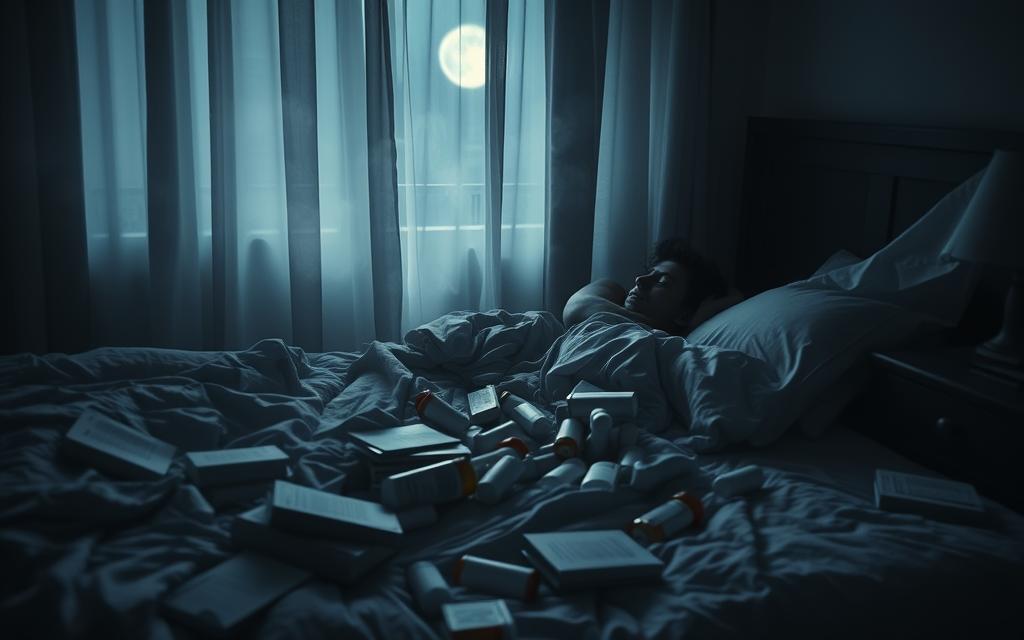
Narcolepsy is when you’re very sleepy during the day. It starts between 15 and 30 years old, with sleep attacks lasting about 15 minutes6. It makes it hard to fall asleep and stay asleep.
In short, sleep disorders like insomnia, sleep apnea, RLS, and narcolepsy are big challenges. Each one needs special care and treatment to help people feel better7.
Common Causes of Sleep Disorders
Lifestyle choices greatly affect how well we sleep. Irregular sleep times and not enough exercise can disrupt sleep. Drinking too much caffeine and alcohol also leads to insomnia and poor sleep.
About 30% of adults deal with insomnia at some point. Stress and hormonal changes are big contributors to this problem7. Not getting enough sleep can make us feel irritable, anxious, and less sharp. This affects our daily lives and work performance7.

Lifestyle and sleep are closely linked, not just through what we eat and drink. Chronic pain, needing to pee a lot, and mental health issues also play a part. As people get older, the risk of sleep disorders grows, hitting older adults and women hard8.
Changing our lifestyle is key to better sleep and fewer sleep disorders. This is important for all kinds of people.
Common Sleep Disorders and Their Symptoms
Sleep disorders affect millions, causing daytime impairment. Insomnia is a big problem, with over 30% of adults struggling to sleep9. It comes in three types: chronic, intermittent, and transient. Chronic insomnia lasts a month or more, leading to long sleep times and poor sleep quality8.
Women are more likely to have insomnia than men9. This can make daily life tough.
Sleep apnea is another disorder, where breathing stops for ten seconds or more during sleep. It’s common in older adults and affects daytime impairment1. Restless Leg Syndrome (RLS) makes people want to move their legs at night, making sleep hard1.
Insomnia’s signs aren’t just about not sleeping. They can also include feeling irritable, unfocused, and tired during the day8. About 10% of adults deal with insomnia for over five years, showing its big impact on life9. Knowing about these disorders and their signs is key to finding good treatments and better sleep.
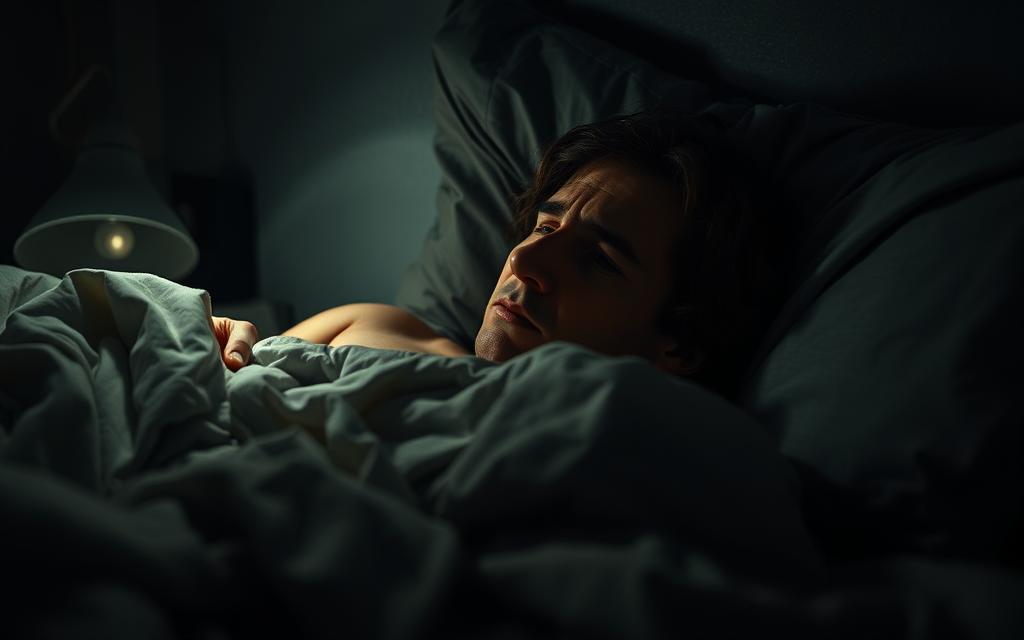
Diagnosis of Sleep Disorders
Diagnosing sleep disorders starts with a detailed medical history. This includes looking at sleep habits, lifestyle, and any health issues. Doctors might recommend sleep studies to fully understand sleep patterns. For example, the Multiple Sleep Latency Test (MSLT) checks daytime sleepiness through naps, helping diagnose sleep disorders10.
Polysomnography is a key sleep study. It records brain activity, oxygen levels, heart rate, and breathing at night. It also tracks eye and leg movements, giving a complete view of the sleep cycle10. Home sleep apnea tests let people test themselves for sleep apnea, gathering important data on breathing and oxygen levels11.
Actigraphy monitors track movement during sleep, providing insights into sleep-wake cycles10. For sleep apnea, spotting big drops in oxygen levels at night helps decide on treatments like CPAP therapy11. Using these tools well is key to creating effective treatment plans.
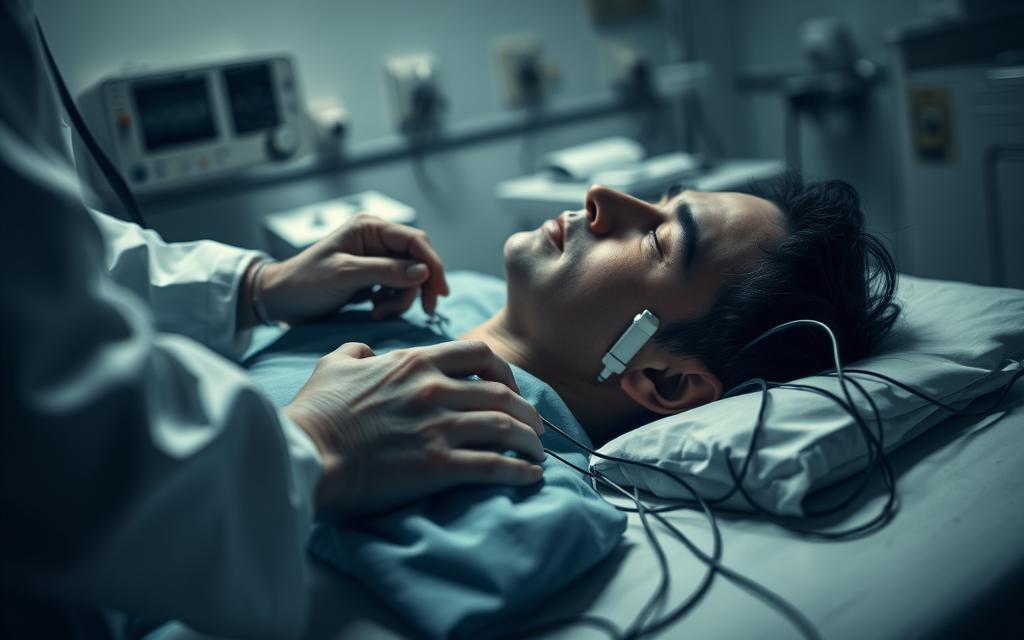
Effective Treatments for Insomnia
Cognitive behavioral therapy is seen as the best first choice for insomnia, helping about 70% of people sleep better12. It works by changing negative thoughts about sleep. Techniques like sleep hygiene education and sleep restriction are used13. This method is often as good as, or even better than, sleep medicines14.
Doctors usually don’t recommend sleep medicines for long because of the risk of addiction14. For trouble falling asleep, medicines like Eszopiclone and Ramelteon are options14. For staying awake or waking up too early, Doxepin and Suvorexant are approved14.
Improving sleep can also come from simple lifestyle changes. Keeping a regular sleep schedule and avoiding naps can help a lot12. About 60% of people with insomnia see big improvements in their sleep this way12. Yet, insomnia costs the U.S. about $63 billion a year, showing how big of a problem it is12.
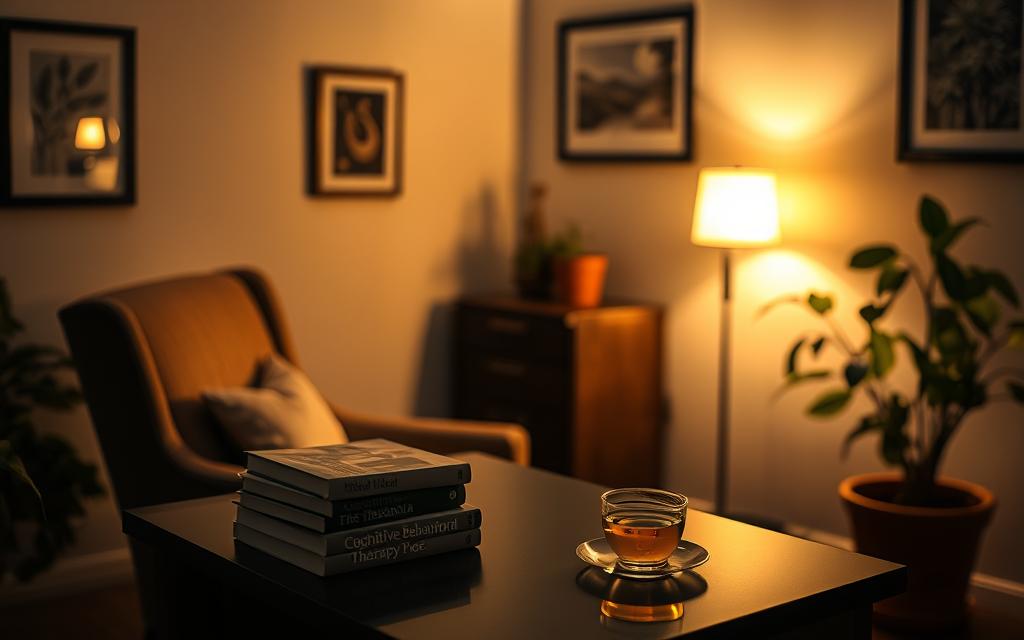
| Treatment Method | Description | Effectiveness |
|---|---|---|
| Cognitive Behavioral Therapy (CBT) | Focuses on changing negative thought patterns regarding sleep. | 70% success rate in improving sleep quality. |
| Prescription Medications | Includes options like Eszopiclone and Doxepin. | Generally effective, but may not be suitable for long-term use. |
| Lifestyle Changes | Involves maintaining a consistent sleep schedule and limiting naps. | Approximately 60% see significant improvements. |
Addressing Sleep Apnea
Sleep apnea affects millions of Americans, causing serious health problems if not treated. CPAP therapy is the top choice for treating sleep apnea. It keeps airways open by sending air pressure through a mask at night. This is very effective for those with moderate to severe sleep apnea, helping prevent airway collapse and improve sleep.
About 50% of people using CPAP machines find it hard to get used to. Other options like oral appliances might be easier but less effective. Surgery is usually a last resort, after trying other treatments for at least three months.
For CPAP therapy to work, it’s key to be comfortable and consistent. Regular check-ups with doctors can help make the device fit better and work better. Also, losing weight and exercising can help with sleep apnea symptoms, showing the need for a complete treatment plan15.
| Treatment Type | Effectiveness | Comfort Level |
|---|---|---|
| CPAP Therapy | High | Variable |
| Oral Appliances | Moderate | Higher |
| Surgical Options | Dependent on Method | Mixed |
Managing Restless Legs Syndrome
Managing restless legs syndrome (RLS), also known as Willis-Ekbom Disease, requires a mix of lifestyle changes and medical treatments. Symptoms get worse when you’re not moving and are most severe at night16. People often feel an intense urge to move their legs and feel uncomfortable sensations that get better when they move.
These feelings can happen a few times a week for some, but more often for others16.
Making lifestyle changes is key to managing RLS. Regular exercise is helpful, but try to avoid it before bedtime17. Good sleep habits, like a consistent sleep schedule and at least seven hours of sleep, can also help18. Avoiding caffeine, tobacco, and alcohol in the evening can also help control symptoms17.
For more severe cases, medication is often needed. First, doctors might try anti-seizure drugs like gabapentin and pregabalin, or dopaminergic agents like ropinirole and pramipexole18. If someone has low iron, taking iron supplements can help, as iron levels in the brain are linked to RLS16. A new treatment, FDA-approved tonic motor activation (TOMAC) technology, aims to reduce symptoms and improve sleep.
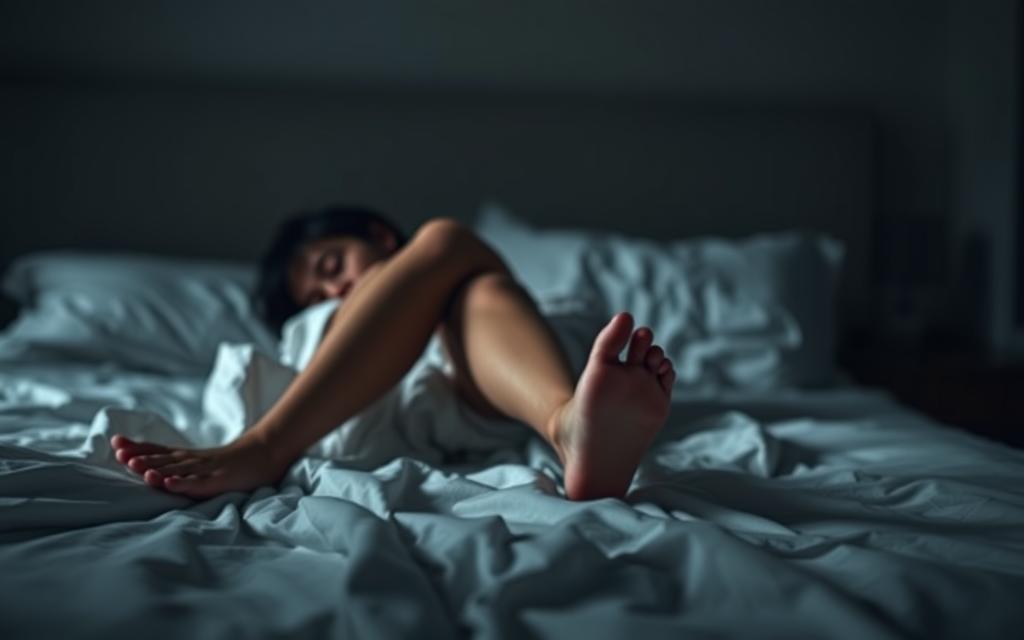
Support groups are also important for finding ways to cope and for community support. Each person’s treatment plan should be unique, based on their specific symptoms and what’s causing their RLS17.
Narcolepsy Management Strategies
Narcolepsy affects about 25 to 50 people per 100,000 worldwide. Around 20% have type 1, with cataplexy, and 80% have type 2 without cataplexy19. People with narcolepsy often feel very sleepy during the day, sometimes suddenly19. To manage this, doctors might prescribe medications like modafinil to help stay alert20.
Treatment plans vary and may include lifestyle changes and medication. It’s all about finding what works best for each person.

Short naps are good for those with narcolepsy. Sleep experts help plan these naps throughout the day20. A regular bedtime routine and consistent sleep schedule also help manage symptoms20.
Exercising regularly, 4 to 5 hours before bedtime, can help sleep better at night and stay alert during the day21.
Medications like modafinil and armodafinil are often used for narcolepsy. They are less likely to cause addiction compared to older drugs21. But, they can cause side effects like headaches, nausea, and anxiety21.
Sodium oxybate helps with cataplexy and nighttime sleep. But, it might make some people feel nauseous or experience sleepwalking21. Knowing how to manage narcolepsy can greatly improve a person’s life.
Understanding Parasomnia Treatments
Treating parasomnias is key for safety and quality of life. Safety measures are crucial to prevent injuries during sleep disturbances. For example, kids with night terrors, affecting 40% of 2- to 6-year-olds, need a structured sleep environment22.
Scheduled awakenings can also help with sleepwalking. This behavior affects 15% of 2- to 6-year-olds and can happen during naps2223.
For severe cases, medication is needed. Options include topiramate, antidepressants, and melatonin, chosen based on individual needs23. Sleep-focused cognitive behavioral therapy is also effective, helping with parasomnias linked to mental health issues. About 50% of children have nightmares that can disrupt sleep22.
It’s important to understand each parasomnia type. REM sleep behavior disorder (RBD) affects less than 1.5% of people, causing them to act out dreams22. This shows the need for a tailored approach in managing parasomnias. Each case is unique, from sleepwalking to bedwetting, which is common in young children2223.
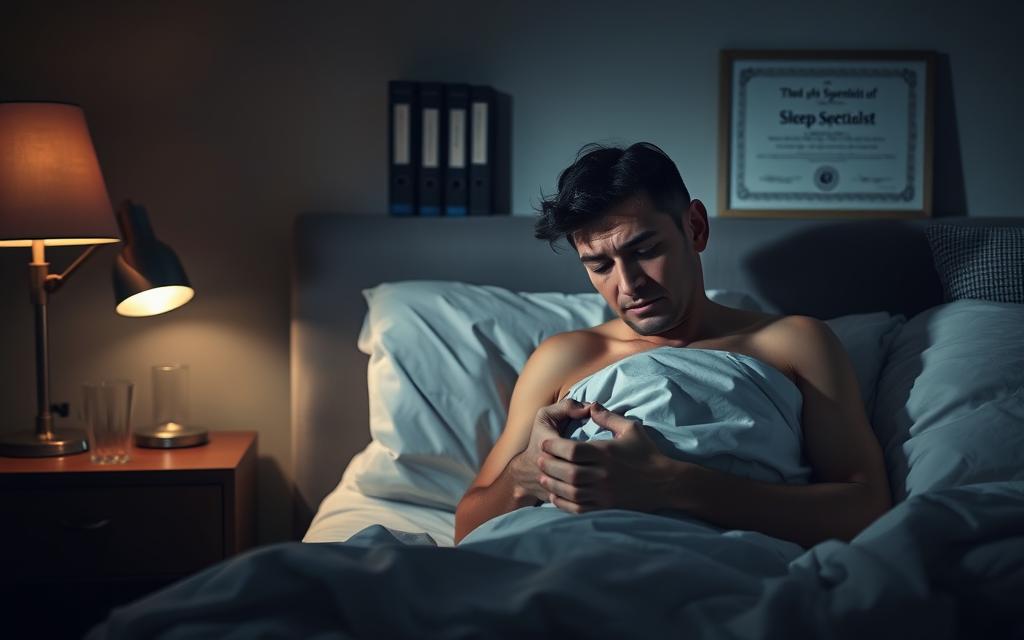
Circadian Rhythm Disorders and Treatment
Circadian rhythm disorders affect about 10% of people, causing sleep problems and daily life issues24. Delayed Sleep-Wake Phase Disorder (DSWPD) is the most common, hitting teens and young adults hard25. It leads to insomnia in 30% of adults and sleep issues in 25% of shift workers, showing the need for managing circadian rhythms2425.
Melatonin therapy is a key treatment, with success rates close to 70% in studies24. It helps people fall asleep 15 to 30 minutes faster, aiding those with these disorders24. Keeping a regular sleep schedule and avoiding bright lights before bed are crucial26.
Changing sleep habits can improve sleep quality by up to 50% for those affected24. Light therapy is a mainstay treatment, helping shift the sleep cycle by 1 to 2 hours with morning bright light2426. It’s also important to watch caffeine intake, avoiding it in the evening to support healthy sleep cycles25.
Sleep Hygiene Practices for Better Sleep
Creating a cozy sleep space is key for better sleep. Keeping your bedroom at 65 degrees Fahrenheit makes it perfect for sleep27. Using heavy curtains or eye masks helps block out light, ensuring you sleep without interruptions27.
Going to bed and waking up at the same time every day is important. It helps your body get into a regular sleep pattern, which is good for your health27.
To get better sleep, try going to bed a bit earlier or later. This helps your body adjust without messing up your routine27. Make sure your bed is only for sleeping and intimacy. This helps your brain connect bed with sleep27.
Short naps in the afternoon can give you a boost without messing up your night’s sleep27.
Regular exercise can make you healthier and sleep better27. Avoiding caffeine and alcohol in the afternoon and evening helps you sleep well27. Also, eating big meals too close to bedtime can disrupt your sleep27.
Smoking can make it hard to sleep well, so it’s best to avoid it27.
Using calming scents like lavender can help you relax and sleep better27. It’s important for everyone to have good sleep habits, no matter their age28. By following these tips, you can create a sleep-friendly environment for restful nights.
Conclusion
Dealing with sleep disorders is more than just about feeling good. It’s about keeping your health and life quality up. About 50–70 million American adults have sleep disorders, showing how common it is29. Knowing the signs, reasons, and treatments is key for those affected.
One-third of adults say they have insomnia, making sleep very important30. Good sleep habits, lifestyle changes, and doctor visits can really help. People who don’t sleep enough have worse health than those who do, showing sleep’s value9.
In short, knowing about sleep disorders helps people improve their sleep. By making smart choices and getting the right help, people can greatly improve their health and life quality. This shows how crucial it is to tackle sleep disorders for better wellness.
FAQ
What are the most common sleep disorders?
Common sleep disorders include insomnia and sleep apnea. Restless leg syndrome, narcolepsy, and parasomnias are also common. Circadian rhythm disorders affect many people too.
How can I tell if I have insomnia?
Insomnia makes it hard to fall or stay asleep. You might feel tired, irritable, and have trouble concentrating during the day. If these problems last, see a doctor.
What is sleep apnea and how is it treated?
Sleep apnea causes breathing stops during sleep. A CPAP machine helps keep airways open. Changing your lifestyle and managing your weight can also help.
What is restless leg syndrome (RLS)?
RLS makes your legs feel uncomfortable and urges you to move them at night. Try regular exercise, leg massages, and medications like dopaminergic agonists and iron if needed.
How is narcolepsy diagnosed and treated?
Narcolepsy is diagnosed with sleep studies and clinical checks. Treatment includes stimulant meds for daytime sleepiness and lifestyle changes.
What are parasomnias, and what should I do if I experience them?
Parasomnias are odd behaviors during sleep, like sleepwalking. To stay safe, take precautions. In severe cases, medication might be needed.
How can I improve my circadian rhythm disorders?
Melatonin therapy can help adjust your sleep-wake cycle. Stick to a sleep schedule and improve your sleep environment too.
What are some effective sleep hygiene practices?
Good sleep hygiene includes a regular sleep schedule and a comfy sleep space. Avoid screens before bed and limit caffeine and alcohol. Relaxation techniques also help.
Should I see a doctor if I have sleep issues?
Yes, if you have ongoing sleep problems or symptoms of sleep disorders, see a doctor. They can assess and suggest treatments to improve your sleep.
Source Links
- Sleep Disorders | MedlinePlus – https://medlineplus.gov/sleepdisorders.html
- Sleep disorders – Symptoms and causes – https://www.mayoclinic.org/diseases-conditions/sleep-disorders/symptoms-causes/syc-20354018
- Sleep Disorders – https://www.sleepfoundation.org/sleep-disorders
- Common Sleep Disorders in Adults: Diagnosis and Management – https://www.aafp.org/pubs/afp/issues/2022/0400/p397.html
- Understanding Sleep Disorders | Brain Institute – https://www.ohsu.edu/brain-institute/understanding-sleep-disorders
- Common Sleep Disorders – UChicago Medicine – https://www.uchicagomedicine.org/conditions-services/sleep-disorders/common-sleep-disorders
- Types of Sleep Disorders | Aurora Health Care – https://www.aurorahealthcare.org/services/sleep-disorders/types-of-sleep-disorders
- Sleep Disorders: Causes, Diagnosis, & Treatments – https://www.healthline.com/health/sleep/disorders
- Sleep Disorder – StatPearls – NCBI Bookshelf – https://www.ncbi.nlm.nih.gov/books/NBK560720/
- Sleep disorders – Diagnosis and treatment – https://www.mayoclinic.org/diseases-conditions/sleep-disorders/diagnosis-treatment/drc-20572160
- Sleep Tests and Treatments – https://www.hopkinsmedicine.org/sleep-medicine/tests-treatments
- Insomnia: What It Is, Causes, Symptoms & Treatment – https://my.clevelandclinic.org/health/diseases/12119-insomnia
- Treatments for Insomnia – https://www.sleepfoundation.org/insomnia/treatment
- Insomnia – Diagnosis and treatment – https://www.mayoclinic.org/diseases-conditions/insomnia/diagnosis-treatment/drc-20355173
- Sleep apnea – Diagnosis and treatment – https://www.mayoclinic.org/diseases-conditions/sleep-apnea/diagnosis-treatment/drc-20377636
- Restless Legs Syndrome – https://www.ninds.nih.gov/health-information/disorders/restless-legs-syndrome
- Restless legs syndrome – Treatment – https://www.nhs.uk/conditions/restless-legs-syndrome/treatment/
- Restless legs syndrome – Diagnosis and treatment – https://www.mayoclinic.org/diseases-conditions/restless-legs-syndrome/diagnosis-treatment/drc-20377174
- Narcolepsy: What It Is, Causes, Symptoms & Treatment – https://my.clevelandclinic.org/health/diseases/12147-narcolepsy
- Narcolepsy – Treatment – https://www.nhs.uk/conditions/narcolepsy/treatment/
- Narcolepsy – Diagnosis and treatment – https://www.mayoclinic.org/diseases-conditions/narcolepsy/diagnosis-treatment/drc-20375503
- Parasomnias – https://www.sleepfoundation.org/parasomnias
- Parasomnia (Sleep Disorder): Symptoms, Causes, Types, Treatment – https://www.healthline.com/health/parasomnia
- Time Difference: When Your Circadian Rhythm Doesn’t Sync Up – https://my.clevelandclinic.org/health/diseases/12115-circadian-rhythm-disorders
- Circadian Rhythm Sleep Disorders: Types and Treatments – https://www.sleepfoundation.org/circadian-rhythm-sleep-disorders
- Circadian Rhythm Sleep Disorder – https://www.healthline.com/health/circadian-rhythm-sleep-disorder
- Mastering Sleep Hygiene: Your Path to Quality Sleep – https://www.sleepfoundation.org/sleep-hygiene
- About Sleep – https://www.cdc.gov/sleep/about/index.html
- Overview of Common Sleep Disorders and Intersection with Dermatologic Conditions – https://pmc.ncbi.nlm.nih.gov/articles/PMC4881480/
- What are Sleep Disorders? – https://www.psychiatry.org/patients-families/sleep-disorders/what-are-sleep-disorders
